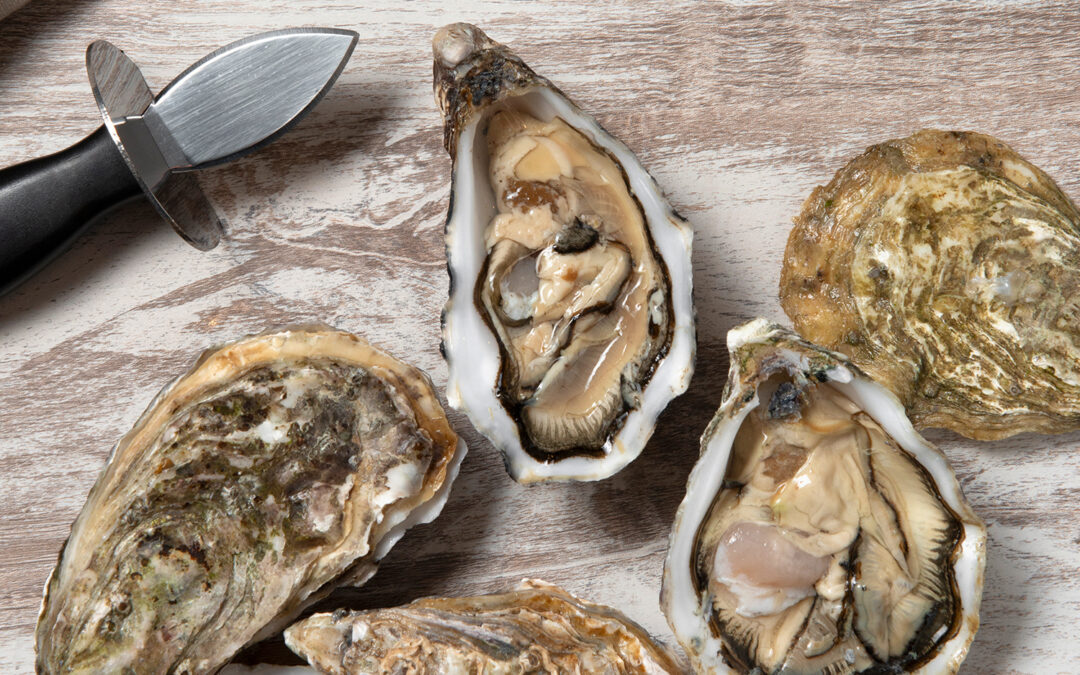Emblems of the ARCACHON BAY
by JP et MC Tavin
Symbol of the purity of its waters, the oyster has always been consumed: The Arcachon bay, a true inland sea, is a protected universe, partly closed by a dune cordon. Fed by the Leyre and the tides, it is a leading oyster farm recognized for the quality of its waters.
A little history
Pick-up and Pickup. Already prehistoric men consumed it as evidenced by the remains of shells unearthed on some sites of excavations. The Romans carried them from Gaul and consumed them at banquets. But its true trade began in the 17th century. A profitable trade that caused excessive fishing exhausting the natural resource. In 1750 fishing and the oyster trade were suspended for three years. Picking and trade are picking up again and will see alternating periods of scarcity and other abundance.
Oyster farming in the Arcachon Bay
Oyster «culture» began in the 19th century with oyster farms conducive to the proliferation of oysters. In 1859 the imperial parks were set up, marking the beginning of a rapid development of oyster farming in the Arcachon bay. The culture of the oyster flat the first successes: «golden age» of the oyster culture. From 1870 to 1875, the number of parks operated increased fivefold, from 500 to more than 2500, a figure that continued to increase until 1890. Commercial oysters are those called farmed and semi-farmed. They are shipped to all other French and European oyster farming centres.
The first crises, the challenges
In 1920, the flat oyster was decimated throughout France by an epizootic. Oyster farmers had to find another way to produce. They then begin to grow «the Portuguese oyster».
The fight to maintain the quality of the environment
From 1930 to 1970, production increased almost steadily. From 1960 to 1970 the high density of livestock and the poor quality of the waters of the Basin caused a decline in production. Oyster farmers are calling for better management of urban and industrial wastewater discharges at the Bay level. This request led to the creation, in 1964, of an organization responsible for the establishment of sewerage networks: the Syndicat Intercommunal du Bassin d’Arcachon (SIBA). In 1971 the Portuguese oyster was decimated by an epizootic. It is then replaced during an experimental import operation by the Japanese oyster: Crassostrea gigas.
An encouraging recovery
The recovery was rapid, and the import of oysters and spat from Japan and Canada quickly paid off. This period also marks a change in oyster marketing practices, from shipping to direct sales.
The TBT crisis: once again the deterioration of water quality threatens production
In 1974, oyster farming suffered a new crisis, the so-called tributyltin (TBT). This toxic compound, present in new paints of anti-fouling boats, disrupts the reproduction of oysters and alters the calcification of their shell. From 1977 to 1982, the spat harvest was almost nil. Production collapsed and bankruptcies were numerous. In 1982, France regulated the use of TBT in nautical paintings. Capture became abundant again and anomalies faded.
Recent technical and technological developments
In 1995 IFREMER invented the triploid oyster: provided by hatcheries, they are sterile and do not devote energy to their reproduction. In the 1990s, deep-sea farming techniques arrived in the Bay. The cages containing the bags are immersed continuously, which allows to accelerate the «growth» of the oysters.
The current threat of juvenile mortality
Since 2008, there has been a national summer mortality crisis for young oysters due to herpes virus OsHV1. However, since 2013 there has been a significant decrease in the phenomenon, but this remains a source of concern with a resumption of mortality in 2016. The year 2020 is marked by several waves of significant deaths, without the cause being clearly established. Professionals note a correlation between heavy rains and the occurrence of these deaths. Recent years have seen an increase in periods of prohibition. The oyster industry, worried, is in discussion ( animated ) with the water and effluent managers of the municipalities of the Bay. Real estate pressure, rising attendance are generating an imbalance of the natural environment.
The oyster farming villages
Since the last century, the Arcachon Bay has become one of the most important French oyster farming centres. Built of wood, the huts are real villages. They are found on the Île aux Oiseaux, as on the Lège-Cap Ferret peninsula or in the oyster ports of Gujan-Mestras and La Teste-de-Buch. There are a total of 1,500 huts scattered around the basin and built along the beach.
During your visit, you can stop there to taste the famous oysters that are the pride of the Arcachon Bay.



